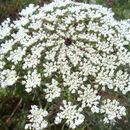en
names in breadcrumbs


The best known predator of Wild Carrot in eastern North America is the Black Swallowtail (Papilio polyxenes), the caterpillar larvae of which feed on a range of plants in the carrot family (Apiaceae, formerly Umbelliferae), as well as the citrus family (Rutaceae).(Wagner 2005)
Umehara et al. (2005) observed insect visitors (potential pollinators) to Wild Carrot in Japan, recording visits from a variety of syrphid (and other) flies, bee, and other insects.
The carrot (Daucus carota) includes, among other named subspecies, both Wild Carrot (Daucus carota carota) and the domesticated forms commonly treated as a distinct subspecies, D. carota sativus.
Chromosome number is 2n=18 (Gleason and Cronquist 1991).
The domesticated carrot (D. carota sativus) is grown throughout the world.
Wild carrot (D. carota carota) is native to temperate regions of Europe and western Asia, and has been introduced into America, New Zealand, Australia and Japan (Rong et al. 2010 and references therein).
Wild carrot is found throughout the eastern states and along the south and west coasts of the United States, in Canada, Mexico, Central America, and the West Indies. It occurs throughout the British Isles, where it is especially abundant near the sea. It also occurs from Norway and central Sweden south to North Africa and the Canary Islands, and eastward through Siberia to northern and eastern India. (Mitich 1996 and references therein)
There are around 5 dozen Daucus species worldwide (Gleason and Cronquist 1992). In the northeastern United States, there is one other Daucus, D. pusillus, which is widespread in the southern U.S. In contrast to D. carota, D. pusillus has involucral bracts that are not scarious-margined (scarious-margined below in D. carota) and that are appressed to the umbel in fruit (spreading or reflexed in D. carota). (Gleason and Cronquist 1992)
A number of other members of the carrot family--including some dangerously poisonous ones--bear some resemblance to Wild Carrot. For example, Fool's Parsley (Aethusa cynapium) and the Poison Hemlock (Conium maculatum) that supposedly killed Socrates could be confused with Wild Carrot (both of these plants, however, have hairless stems and unpleasant-smelling foliage, among other differences). (Stokes and Stokes 1985)
Umehara et al. (2005) showed that wild and cultivated carrots can produce vigorous hybrid offspring and developed genetic markers that could be useful in tracing inrogression of genes from cultivated carrots into wild populations. Such introgression is of particular concern in considering the possible risks of genes inserted into cultivated varieties escaping into wild populations and creating "superweeds" or other problems.
Daucus carota is considered a problematic weed in much of its range (at least where it is not native). One subspecies, the domesticated D. carota sativus, is an important vegetable cultivated worldwide and is an excellent source of vitamin A precursor.